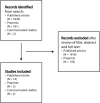Sinonasal pathophysiology of SARS-CoV-2 and COVID-19: A systematic review of the current evidence
- PMID: 32587887
- PMCID: PMC7262250
- DOI: 10.1002/lio2.384
Sinonasal pathophysiology of SARS-CoV-2 and COVID-19: A systematic review of the current evidence
Abstract
Objective: The ongoing pandemic of coronavirus disease (2019 coronavirus disease [COVID-19]), caused by the Severe Acute Respiratory Syndrome Coronavirus 2 (SARS-CoV-2) virus, is highly contagious with high morbidity and mortality. The role of the nasal and paranasal sinus cavities is increasingly recognized for COVID-19 symptomatology and transmission. We therefore conducted a systematic review, synthesizing existing scientific evidence about sinonasal pathophysiology in COVID-19.
Study design: Systematic review.
Methods: Systematic searches were performed of all indexed studies in PubMed/Medline and Cochrane databases through 28 March 2020 and studies searchable on preprints.com (including ArXiv and Scilit repositories) through 30 March 2020. Data extraction focused on sinonasal pathophysiology in COVID-19.
Results: A total of 19 studies were identified. The sinonasal cavity may be a major site of infection by SARS-CoV-2, where susceptibility genes required for infection are expressed at high levels and may be modulated by environmental and host factors. Viral shedding appears to be highest from the nose, therefore reflecting a major source for transmission. This has been highlighted by multiple reports of health care-associated infection (HAI) during rhinologic procedures, which are now consequently considered to be high risk for SARS-CoV-2 transmission to health care workers. While sinonasal symptomatology, such as rhinorrhea or congestion, appears to be a rarer symptom of COVID-19, anosmia without nasal obstruction is reported as highly specific predictor of COVID-19+ patients.
Conclusion: Sinonasal pathophysiology is increasingly important in our understanding of COVID-19. The sinonasal tract may be an important site of infection while sinonasal viral shedding may be an important transmission mechanism-including HAI. Anosmia without nasal obstruction may be a highly specific indicator of COVID-19.
Level of evidence: 2a.
Keywords: COVID‐19; SARS; SARS‐CoV2; SARS‐CoV‐2; anosmia; congestion; coronavirus; nose; olfactory dysfunction; paranasal sinus; respiratory epithelium; rhinorrhea; sinonasal; systematic review; transmission.
© 2020 The Authors. Laryngoscope Investigative Otolaryngology published by Wiley Periodicals, Inc. on behalf of The Triological Society.
Conflict of interest statement
The authors declare no potential conflict of interest.
Figures
Similar articles
-
Olfactory Dysfunction and Sinonasal Symptomatology in COVID-19: Prevalence, Severity, Timing, and Associated Characteristics.Otolaryngol Head Neck Surg. 2020 Jul;163(1):114-120. doi: 10.1177/0194599820929185. Epub 2020 May 19. Otolaryngol Head Neck Surg. 2020. PMID: 32423357 Free PMC article.
-
Pathophysiology of SARS-CoV-2 Infection of Nasal Respiratory and Olfactory Epithelia and Its Clinical Impact.Curr Allergy Asthma Rep. 2023 Feb;23(2):121-131. doi: 10.1007/s11882-022-01059-6. Epub 2023 Jan 4. Curr Allergy Asthma Rep. 2023. PMID: 36598732 Free PMC article. Review.
-
Sinonasal manifestations and dynamic profile of RT-PCR results for SARS-CoV-2 in COVID-19 patients.Ann Palliat Med. 2021 Apr;10(4):4174-4183. doi: 10.21037/apm-20-2493. Epub 2021 Mar 23. Ann Palliat Med. 2021. PMID: 33832289
-
Universal screening for SARS-CoV-2 infection: a rapid review.Cochrane Database Syst Rev. 2020 Sep 15;9(9):CD013718. doi: 10.1002/14651858.CD013718. Cochrane Database Syst Rev. 2020. PMID: 33502003 Free PMC article.
-
Aggregate Prevalence of Chemosensory and Sinonasal Dysfunction in SARS-CoV-2 and Related Coronaviruses.Otolaryngol Head Neck Surg. 2020 Jul;163(1):156-161. doi: 10.1177/0194599820929278. Epub 2020 May 19. Otolaryngol Head Neck Surg. 2020. PMID: 32423285 Review.
Cited by
-
Persistent ENT Manifestations in Individuals who Recovered from COVID-19: A Systematic Review.Int Arch Otorhinolaryngol. 2024 Mar 15;28(4):e697-e701. doi: 10.1055/s-0043-1777805. eCollection 2024 Oct. Int Arch Otorhinolaryngol. 2024. PMID: 39464351 Free PMC article. Review.
-
Postulated Adjuvant Therapeutic Strategies for COVID-19.J Pers Med. 2020 Aug 5;10(3):80. doi: 10.3390/jpm10030080. J Pers Med. 2020. PMID: 32764275 Free PMC article. Review.
-
Olfactory dysfunction during COVID-19 pandemic.Med Clin (Engl Ed). 2020 Nov 13;155(9):403-408. doi: 10.1016/j.medcle.2020.06.023. Epub 2020 Oct 9. Med Clin (Engl Ed). 2020. PMID: 33072867 Free PMC article. No abstract available.
-
Alteration of Smell and Taste Sensations in Covid-19 Positive Patients: A Prospective Cohort Study in Western India.Indian J Otolaryngol Head Neck Surg. 2021 Sep;73(3):371-377. doi: 10.1007/s12070-021-02670-1. Epub 2021 Jun 8. Indian J Otolaryngol Head Neck Surg. 2021. PMID: 34123736 Free PMC article.
-
Nanomaterials to combat SARS-CoV-2: Strategies to prevent, diagnose and treat COVID-19.Front Bioeng Biotechnol. 2022 Nov 25;10:1052436. doi: 10.3389/fbioe.2022.1052436. eCollection 2022. Front Bioeng Biotechnol. 2022. PMID: 36507266 Free PMC article. Review.
References
Publication types
LinkOut - more resources
Full Text Sources
Other Literature Sources
Medical
Research Materials
Miscellaneous

